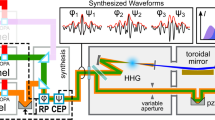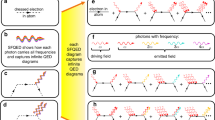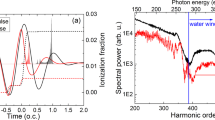Abstract
Many intriguing phenomena in nature—from phase transitions to black holes—occur at singularities. A unique type of singularity common in wave phenomena, known as caustics1,2, links processes observed in many different branches of physics3,4. Here, we investigate the role of caustics in attosecond science and in particular the physical process behind high harmonic generation5. We experimentally demonstrate spectral focusing in high harmonic generation, showing a robust intensity enhancement of an order of magnitude over a spectral width of several harmonics. This new level of control holds promises in both scientific and technological aspects of attosecond science6,7. Moreover, our study provides a deeper insight into the basic mechanism underlying the high harmonic generation process, revealing its quantum nature8 and universal properties.
This is a preview of subscription content, access via your institution
Access options
Subscribe to this journal
Receive 12 print issues and online access
$209.00 per year
only $17.42 per issue
Buy this article
- Purchase on Springer Link
- Instant access to full article PDF
Prices may be subject to local taxes which are calculated during checkout


Similar content being viewed by others
References
Berry, M. & Upstill, C. Catastrophe Optics: Morphologies of Caustics and their Diffraction Patterns (Elsevier, 1980).
Kravtsov, Y. A. & Orlov, Y. I. Caustics, catastrophes, and wave fields. Sov. Phys. Usp. 26, 1038–1058 (1983).
Jura, M. P. et al. Unexpected features of branched flow through high-mobility two-dimensional electron gases. Nature Phys. 3, 841–845 (2007).
Gaudie, B. S. Discovery of a Jupiter/Saturn analog with gravitational microlensing. Science 319, 927–930 (2008).
Corkum, P. B. Plasma perspective on strong field multiphoton ionization. Phys. Rev. Lett. 71, 1993–1997 (1993).
Kapteyn, H., Cohen, O., Christov, I. & Murnane, M. Harnessing attosecond science in the quest for coherent X-rays. Science 319, 775–778 (2007).
Krausz, F. & Ivanov, M. Attosecond physics. Rev. Mod. Phys. 81, 163–234 (2009).
Lewenstein, M., Balcou, P., Ivanov, M. Y., L'Huillier, A. & Corkum, P. Theory of high harmonics generation by low frequency laser light. Phys. Rev. A 49, 2117–2132 (1994).
Sandberg, R. et al. Lensless diffractive imaging using tabletop coherent high-harmonic soft-X-ray beams. Phys. Rev. Lett. 99, 098103 (2007).
Goulielmakis, E. et al. Real-time observation of valence electron motion. Nature 466, 739–743 (2010).
Frolov, M. V., Manakov, N., Silaev, A. A. & Vedenskii, N. V. Analytic description of high order harmonic generation by atoms in a two color laser field. Phys. Rev. A 81, 063407 (2010).
Frolov, M. V., Manakov, N. L., Sarantseva, T. S. & Starace, A. F. Analytic formulae for high harmonic generation. J. Phys. B. 42, 035601 (2009).
Berry, M. V. Focusing and twinkling: critical exponents from catastrophes in non-Gaussian random short waves. J. Phys. A 10, 2061–2081 (1977).
Dudovich, N. et al. Attosecond temporal gating with elliptically polarized light. Phys. Rev. Lett. 97, 253903 (2006).
Gaarde, M. B., L'Huillier, A. & Lewenstein, M. Theory of high-order sum and difference frequency mixing in a strong bichromatic laser field. Phys. Rev. A 54, 4236–4248 (1996).
Figueira, C., Faria, D. M., Milosevic, D. B. & Paulus, G. G. Phase dependent effects in bichromatic high order harmonic generation. Phys. Rev. A 61, 063415 (2000).
Dudovich, N. et al. Measuring and controlling the birth of attosecond XUV pulses. Nature Phys. 2, 781–786 (2006).
Ishii, N. et al. Quantum path selection in high-harmonic generation by a phase-locked two-color field. Opt. Express 16, 20876–20883 (2008).
Liu, T. T., Kanai, T., Sekikawa, T. & Watanabe, S. Significant enhancement of high-order harmonics below 10 nm in a two-color laser field. Phys. Rev. A 73, 063823 (2006).
Mauritsson, J. et al. Attosecond pulse trains generated using two color laser fields. Phys. Rev. Lett 97, 013001 (2006).
Kim, I. J. et al. Highly efficient high-harmonic generation in an orthogonally polarized two-color laser field. Phys. Rev. Lett. 94, 243901 (2005).
Brugnera, L. et al. Enhancement of high harmonics generated by field steering of electrons in a two-color orthogonally polarized laser field. Opt. Lett. 35, 3994–3996 (2010).
Itatani, J. et al. Tomographic imaging of molecular orbitals. Nature 432, 867–871 (2004).
Schafer, K. J., Yang, B., DiMauro, L. & Kulander, K. Above threshold ionization beyond the high harmonic cutoff. Phys. Rev. Lett. 70, 1599–1602 (1993).
Meckel, M. et al. Laser-induced electron tunneling and diffraction. Science 320, 1478–1482 (2008).
Weckenbrock, M. et al. Fully differential rates for femtosecond multi-photon double ionization of neon. Phys. Rev. Lett. 92, 213002 (2004).
Acknowledgements
The authors thank T. Shapira and O. Kfir for useful comments, and the Minerva Foundation, the Israeli Science Foundation and the Crown Center of Photonics for financial support. O.R. acknowledges support from the Converging Technologies Fellowship of the Israeli Ministry of Science.
Author information
Authors and Affiliations
Contributions
O.R. conceived the idea. O.R. and O.P. developed the theory, performed the experiments and analysed the data. All authors contributed in building the experimental set-up and writing the manuscript.
Corresponding author
Ethics declarations
Competing interests
The authors declare no competing financial interests.
Supplementary information
Supplementary information
Supplementary information (PDF 1186 kb)
Rights and permissions
About this article
Cite this article
Raz, O., Pedatzur, O., Bruner, B. et al. Spectral caustics in attosecond science. Nature Photon 6, 170–173 (2012). https://doi.org/10.1038/nphoton.2011.353
Received:
Accepted:
Published:
Issue Date:
DOI: https://doi.org/10.1038/nphoton.2011.353
This article is cited by
-
Non-Hermitian swallowtail catastrophe revealing transitions among diverse topological singularities
Nature Physics (2023)
-
Symmetry gives rise to an elegant catastrophe
Nature Physics (2023)
-
Attosecond spectral singularities in solid-state high-harmonic generation
Nature Photonics (2020)
-
Attosecond imaging of molecules using high harmonic spectroscopy
Nature Reviews Physics (2019)
-
Structured caustic vector vortex optical field: manipulating optical angular momentum flux and polarization rotation
Scientific Reports (2015)



